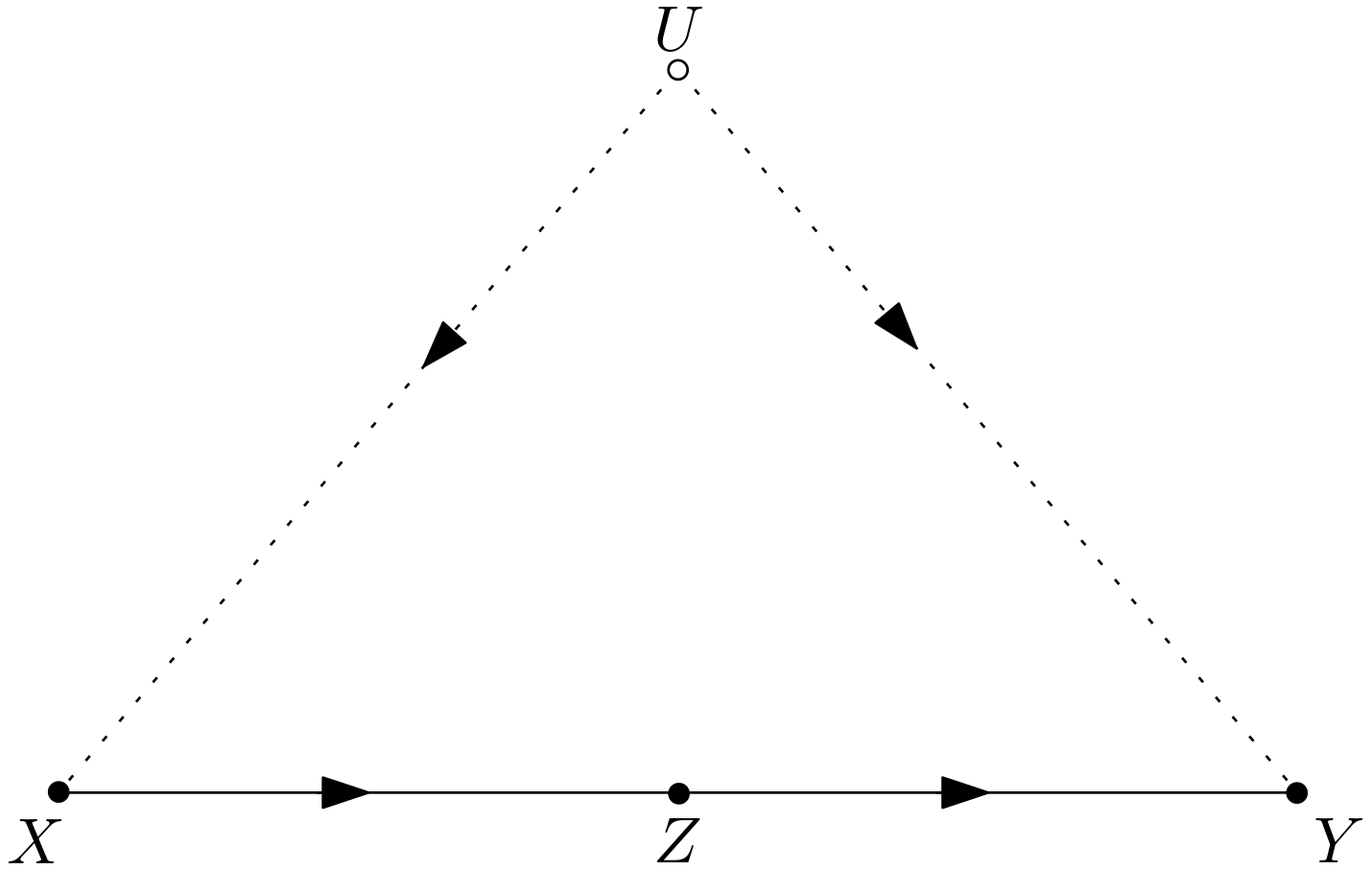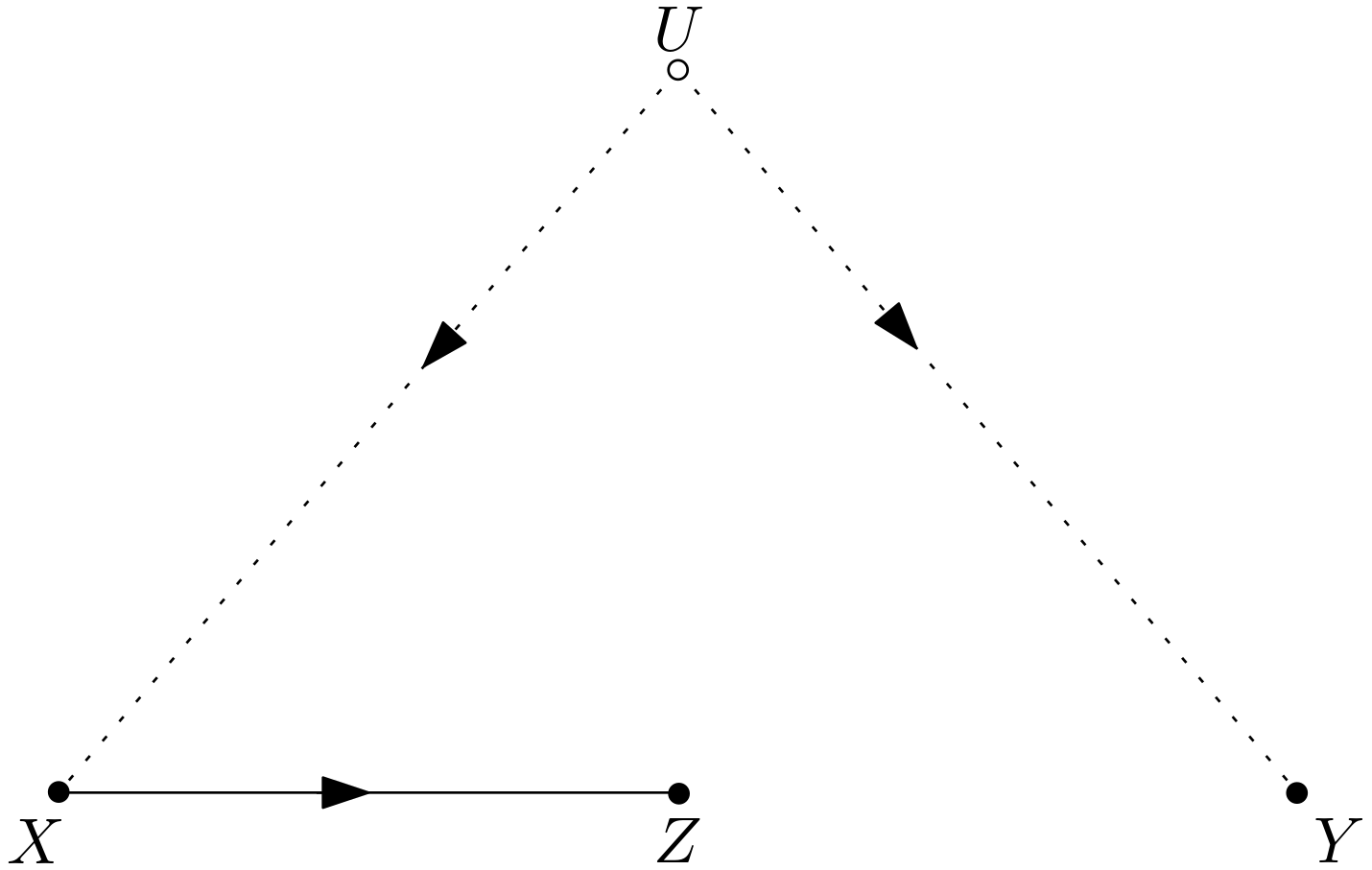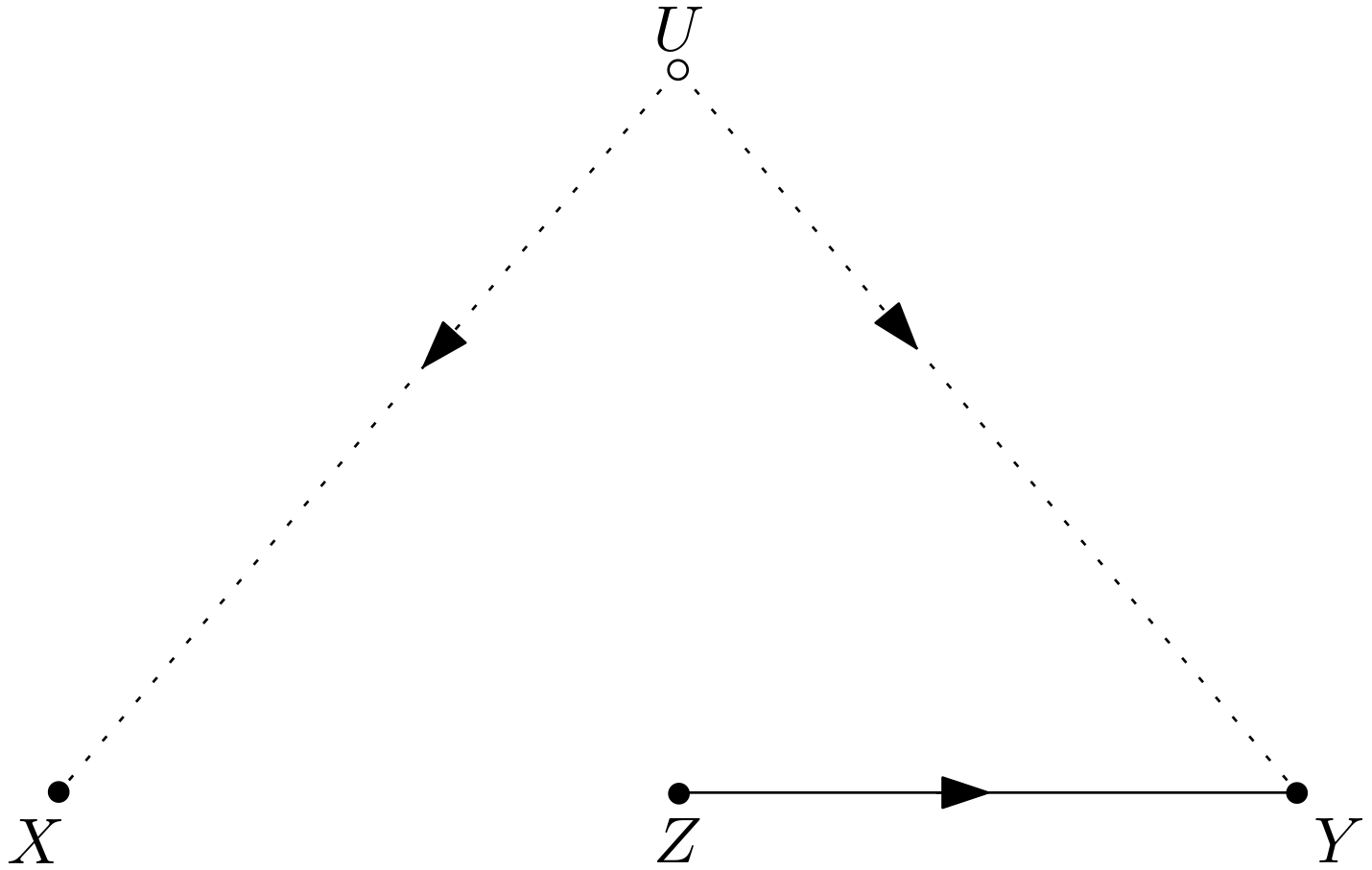Introduction
First of all, this article is best viewed in Chromium and Google Chrome browsers. Some characters are not rendered correctly in Firefox. The computation of a causal effect by means of the do-calculus is elaborated on. The causal effect computation to be elaborated on is the fifth task on page 88 of [1].
The Causal Effect Computation
There is a simple causal model whose directed acyclic graph (DAG) is given in the Figure 1.

As can be seen from the DAG $G$, there are four variables in the model: $U$, $X$, $Y$ and $Z$. $U$ is unobserved. The causal effect to be computed is $p\left(x,y|do\left(z\right)\right)$. This conditional joint probability can be written as follows using the Bayes rule: \begin{equation} p\left(x,y|do\left(z\right)\right)=p\left(x|y,do\left(z\right)\right)p\left(y|do\left(z\right)\right) \end{equation} Let $p\left(x|y,do\left(z\right)\right)$ be attempted for computation. Can the intervention $do \left(z\right)$ be replaced with the observation $Z=z$? \begin{equation} p\left(x|y,do\left(z\right)\right) \stackrel{?}{=} p\left(x|y,z\right) \end{equation} It must be examined if $\left(X \perp \perp Z | Y\right)$ in $G_{\underline{Z}}$. $G_{\underline{Z}}$ is a modified version of the original DAG $G$. The arrows going out of $Z$ are removed from $G$ to obtain $G_{\underline{Z}}$. $G_{\underline{Z}}$ is shown in the Figure 2.

As can easily be detected from $G_{\underline{Z}}$, $X$ and $Z$ are conditionally d-connected given $Y$ through the path $X \rightarrow Z$. Therefore, the intervention on $Z$ cannot be replaced with the observation of $Z$: \begin{equation} p\left(x|y,do\left(z\right)\right) \neq p\left(x|y,z\right) \end{equation}
Can the intervention on $Z$ be removed? \begin{equation} p\left(x|y,do\left(z\right)\right) \stackrel{?}{=} p\left(x|y\right) \end{equation} It must be scrutinized if $\left(X \perp \perp Z | Y\right)$ in $G_{\overline{Z\left(Y\right)}}$. $G_{\overline{Z\left(Y\right)}}$ is a modified version of $G$. The arrows going into $Z$ variable(s) which are not ancestor(s) of $Y$ are removed to get $G_{\overline{Z\left(Y\right)}}$. $Z$ is an ancestor of $Y$. Hence, $G_{\overline{Z\left(Y\right)}}$ is the same as $G$. $X$ and $Z$ are conditionally d-connected given $Y$ in $G$ through either the path $X \rightarrow Z$ or the path $X \leftarrow U \rightarrow Y \leftarrow Z$. So, the intervention on $Z$ cannot be removed: \begin{equation} p\left(x|y,do\left(z\right)\right) \neq p\left(x|y\right) \end{equation}
A way into a solution may be obtained by replacing the observation of $Y$ with the intervention on $Y$. Can the observation of $Y$ be replaced with the intervention on $Y$? \begin{equation} p\left(x|y,do\left(z\right)\right) \stackrel{?}{=} p\left(x|do\left(y\right),do\left(z\right)\right) \end{equation} It must be studied if $X \perp \perp Y$ in $G_{\overline{Z}\underline{Y}}$. $G_{\overline{Z}\underline{Y}}$ can be obtained from $G$ by removing the arrows entering $Z$ and the arrows going out of $Y$. $G_{\overline{Z}\underline{Y}}$ is displayed in the Figure 3.

The graph $G_{\overline{Z}\underline{Y}}$ implies that $X$ and $Y$ are d-connected through the path $X \leftarrow U \rightarrow Y$. This means that the observation of $Y$ cannot be replaced by the intervention on $Y$: \begin{equation} p\left(x|y,do\left(z\right)\right) \neq p\left(x|do\left(y\right),do\left(z\right)\right) \end{equation}
All of the three attempts to initiate a solution by means of the do-calculus rules have not been successful, which means that $p\left(x|y,do\left(z\right)\right)$ cannot be computed for G shown in the Figure 1. Then, the conditional joint probability $p\left(x,y|do\left(z\right)\right)$ must be decomposed as follows: \begin{equation} p\left(x,y|do\left(z\right)\right)=p\left(y|x,do\left(z\right)\right)p\left(x|do\left(z\right)\right) \label{solvable_decomposition} \end{equation} Let $p\left(y|x,do\left(z\right)\right)$ be attempted for computation. Can the intervention on $Z$ be replaced by the observation of $Z$? \begin{equation} p\left(y|x,do\left(z\right)\right) \stackrel{?}{=} p\left(y|x,z\right) \end{equation} Is $\left(Y \perp \perp Z | X \right)$ in $G_{\underline{Z}}$? Yes. From $G_{\underline{Z}}$ shown in the Figure 2, it can be detected that $Y$ is conditionally d-separated from Z given $X$ since the path $Z \leftarrow X \leftarrow U \rightarrow Y$ is blocked by $X$. Then, the intervention on $Z$ can be replaced by the observation of $Z$: \begin{equation} p\left(y|x,do\left(z\right)\right) = p\left(y|x,z\right) \label{first_part} \end{equation} $p\left(y|x,do\left(z\right)\right)$ has been computed. Now, it is the turn of $p\left(x|do\left(z\right)\right)$. Can the intervention on $Z$ be replaced by the observation of $Z$? \begin{equation} p\left(x|do\left(z\right)\right) \stackrel{?}{=} p\left(x|z\right) \end{equation} Is $X \perp \perp Z$ in $G_{\underline{Z}}$? No. From the Figure 2, it can be seen that $X$ and $Z$ are d-connected through the path $X \rightarrow Z$.
Can the intervention on $Z$ be removed? \begin{equation} p\left(x|do\left(z\right)\right) \stackrel{?}{=} p\left(x\right) \end{equation} Is $X \perp \perp Z$ in $G_{\overline{Z}}$? Yes. From the Figure 3, it can be seen that $X$ and $Z$ are d-separated since the path $X \leftarrow U \rightarrow Y \leftarrow Z$ is blocked by the collision node $Y$. Hence, the intervention can be removed to yield the following equality: \begin{equation} p\left(x|do\left(z\right)\right) = p\left(x\right) \label{second_part} \end{equation}
Now, the computation result of the causal effect $p\left(x,y|do\left(z\right)\right)$ can be written using the equations (\ref{solvable_decomposition}), (\ref{first_part}) and (\ref{second_part}) as follows: \begin{equation} p\left(x,y|do\left(z\right)\right)=p\left(y|x,z\right)p\left(x\right) \end{equation}
Conclusion
The computation of the causal effect $p\left(x,y|do\left(z\right)\right)$ for a causal model whose DAG is shown in the Figure 1 has been elaborated on. This problem is the fifth task on page 88 of [1].
References
[1] Judea Pearl, Causality: Models, Reasoning and Inference, Cambridge University Press, 2009.